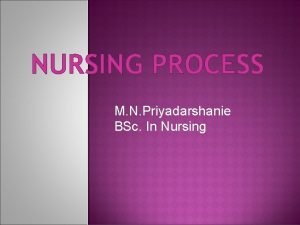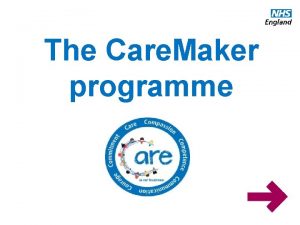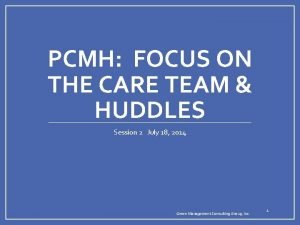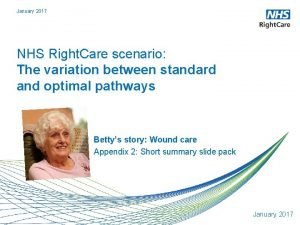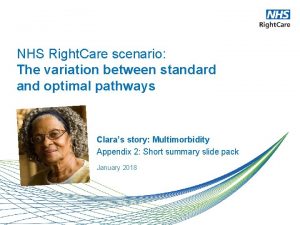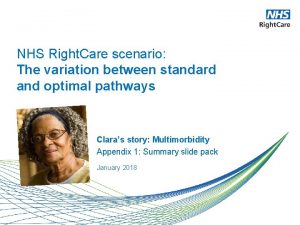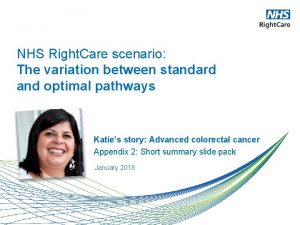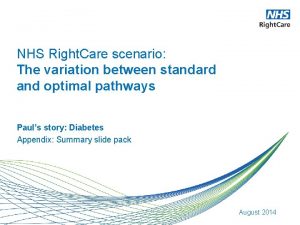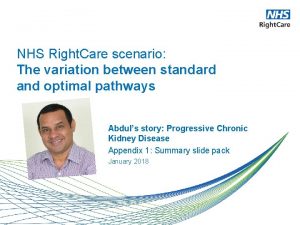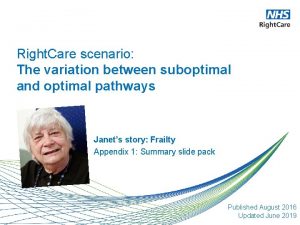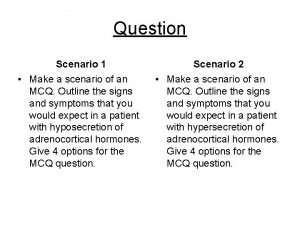January 2017 NHS Right Care scenario The variation















- Slides: 15

January 2017 NHS Right. Care scenario: The variation between standard and optimal pathways Betty’s story: Wound care Appendix 1: Summary slide pack January 2017

Betty’s story This is the story of Betty’s experience of a wound care pathway, and how it could be so much better In this scenario we examine a wound care pathway, comparing a sub-optimal but typical scenario against an ideal pathway. It shows how the NHS Right. Care methodology can help clinicians and commissioners improve the value and outcomes of the care pathway. 1 2 4 3 At each stage we have modelled the costs of care, both financial to the commissioner, and also the impact on the person’s outcomes and experience. This document is intended to help commissioners and providers to understand the implications – both in terms of quality of life and costs – of shifting the care pathway.

Betty and the sub-optimal pathway • Betty is 70 - a retired shop assistant and has a good social network in the village • She has a health check aged 70. Her BMI is 30 and she is invited to see the Health Care Assistant (HCA) for lifestyle advice (the advice was not ideal) • At 74 she grazes her ankle on a walk and after five weeks of self management she visits her GP who issues antibiotics and after two more weeks refers Betty to the General Practice Nurse (GPN) • She is switched to antimicrobial dressing, has a second course of antibiotics and weekly appointments for six weeks (the dressings put a stop to Aquafit classes) • The wound is now very distressing and is having a significant impact on Betty’s life. The health professionals are unaware • Then another change of dressing (to be changed two to three times per week) • Three months on and still no improvement but the GPN is not confident with compression bandaging - better with the status quo than to make a risky mistake with the bandages! • Another month and then a referral to the dermatology dept. (an eight week wait) where the venous leg ulcer is confirmed, but not communicated effectively • It is several months before a doppler scan is undertaken - for a full assessment • A catalogue of incidents occur & Betty’s situation deteriorates further with many extended weeks of pain, discomfort and distress culminating in a five day hospital stay for cellulitis • It takes two years to heal Betty’s ulcer in the end with a reduced compression system that she could tolerate Betty’s case is not unique

Betty and the sub-optimal pathway Prevention Focus Health and wellbeing Care and quality • Delayed healing • Increased side effects and complications • Delayed assessment • Greater understanding of need is required • Poor impact on the patient and staff Poorer outcomes Poorer experience Funding and efficiency • Expensive dressings and treatment • Hospital costs Poorer use of resources

Would you want to avoid this?

Statistics • The annual cost of managing wounds in the NHS and associated comorbidities is £ 5. 3 billion • 1. 5% of the UK population are estimated to have a leg ulcer (of patients recorded in an NHS setting with a wound within one year) • There is evidence of unwarranted variation in the assessment and treatment of leg ulcers (see the main paper and the research studies referenced. ) • Wound care is 39% of a district nursing service workload (NHS Benchmarking 2016 annual audit) Research has shown that the leakage and odour from leg ulcers can cause embarrassment, resulting in social isolation, low mood, depression and poor self-esteem. Interventions to improve leakage and odour have often proved to be inadequate.

Questions for GPs and commissioners 1 Do you know how many venous leg ulcers there are for your population? 2 What are the healing rates for venous leg ulcers in your locality? 3 Do you know how many of these have had an ABPI measurement to support diagnosis and treatment? 4 Who delivers care to people with leg ulcers? 5 What is the cost of managing leg ulcers in your locality? 6 Is there unwarranted variation in treatment and outcomes - how do you know? 7 What are the barriers to seamless care for people with leg ulceration? 8 Has any engagement activity taken place with patients with regards to wound care?

Betty and the optimal pathway • This time (aged 70) Betty’s Health Check is very informative with lots of proactive advice with a personalised care & support plan including an exercise on prescription programme • The GPN review (due to high risk factors) results in a recommendation for compression hosiery and regular reviews • At 74 Betty grazes her ankle whilst rambling and self manages for a few days until consulting the local pharmacist who refers to the lower leg wound pathway (developed by the CCG) • The GPN and the district nursing teams work closely together and so after only four days Betty is referred to the leg ulcer pathway for a full holistic and leg ulcer assessment. • Betty is reassured that pain relief has been carefully planned and she will not become dependent upon the medication • • • The Doppler assessment confirms a venous leg ulcer requiring high compression treatment • • Within eight weeks (start to finish) Betty’s leg is completely healed • Betty is able to have her knee replacement without any delays due to wound complications • Leading Change, Adding Value is a framework for all nursing, midwifery and care staff to use to reduce unwarranted variation The faster the compression treatment starts, the faster healing takes place and that is Betty’s priority Painkillers, bandages and education to Betty are well managed so that Betty keeps the bandages on and everyone can see the improvement; Betty is motivated to stick to the regime Betty then continues to wear compression stockings as a preventative measure

Betty and the optimal pathway Prevention Focus Health and wellbeing Care and quality Funding and efficiency • Faster healing • Reduced side effects • Timely assessment • Greater understanding of need • Reduced dressing costs • Better organisation of care Better outcomes Better experience Better use of resources

50 0 THANET CCG KERNOW CCG LEEDS SOUTH AND EAST CCG NEWARK & SHERWOOD CCG LANCASHIRE NORTH CCG SOUTH WORCESTERSHIRE CCG BRADFORD DISTRICTS CCG BATH AND NORTH EAST SOMERSET CCG SOUTH EASTERN HAMPSHIRE CCG NORTH, EAST, WEST DEVON CCG STOKE ON TRENT CCG SUNDERLAND CCG CALDERDALE CCG ST HELENS CCG SOUTH LINCOLNSHIRE CCG BARNSLEY CCG CHORLEY AND SOUTH RIBBLE CCG KNOWSLEY CCG HAVERING CCG FAREHAM AND GOSPORT CCG NORTH DERBYSHIRE CCG GLOUCESTERSHIRE CCG EAST LANCASHIRE CCG BLACKBURN WITH DARWEN CCG HERTS VALLEYS CCG EASTERN CHESHIRE CCG HORSHAM AND MID SUSSEX CCG GREATER HUDDERSFIELD CCG NORTH KIRKLEES CCG CROYDON CCG HEREFORDSHIRE CCG VALE ROYAL CCG SE STAFFS & SEISDON PENINSULAR CCG TAMESIDE AND GLOSSOP CCG SOUTHAMPTON CCG SANDWELL AND WEST BIRMINGHAM CCG NEWHAM CCG ENFIELD CCG SOUTHPORT AND FORMBY CCG HAMMERSMITH AND FULHAM CCG SOUTH WEST LINCOLNSHIRE CCG HILLINGDON CCG SOUTH WARWICKSHIRE CCG NOTTINGHAM NORTH & EAST CCG HARINGEY CCG CAMDEN CCG SOUTHWARK CCG GREAT YARMOUTH & WAVENEY CCG CENTRAL LONDON (WESTMINSTER) CCG SOMERSET CCG BROMLEY CCG BEDFORDSHIRE CCG STOCKPORT CCG SOUTH READING CCG WARWICKSHIRE NORTH CCG NORTH & WEST READING CCG GREENWICH CCG SURREY DOWNS CCG RUSHCLIFFE CCG HULL CCG CITY AND HACKNEY CCG CAMBRIDGESHIRE AND PETERBOROUGH CCG MILTON KEYNES CCG EAST SURREY CCG EALING CCG CHILTERN CCG LEICESTER CITY CCG SOUTH MANCHESTER CCG NORTH WEST SURREY CCG BRACKNELL AND ASCOT CCG Spend per 100, 000 population (£ 000 s) Spend per 100, 000 of the population on compression bandaging 2015/16 100 90 80 Spend per 100, 000 population 70 60 BASSETLAW CCG 48 40 30 20 10


Financial information Analysis by provider Sub-optimal Optimal Acute £ 1, 703 £ 0 Ambulance service £ 466 £ 0 Community teams £ 2, 167 £ 12 Primary care £ 1, 334 £ 346 Pharmacist £ 3 Leg ulcer pathway £ 0 £ 144 Grand total £ 5, 673 £ 505 In the suboptimal scenario: Dressings represent £ 1, 353 (24%) of the total costs versus £ 88 in the optimal pathway. Clinical time represents £ 2, 139 (38%) of the total costs versus £ 195 in the optimal pathway.

Financial information Analysis by cost category Sub-optimal Optimal Primary care management £ 1, 337 £ 349 Community care £ 2, 167 £ 156 Non-elective admissions £ 2, 169 £ 0 Grand total £ 5, 673 £ 505 Sub Optimal Clinical Time Sub Optimal Prevention Sub Optimal Dressings Sub Optimal Other Primary care £ 935 £ 93 £ 11 £ 222 £ 390 £ 34 £ 0 Community care £ 1, 204 £ 102 £ 0 £ 964 £ 54 £ 0 Non-elective admissions £ 0 £ 0 £ 0 £ 2. 169 Total £ 2, 139 £ 195 £ 11 £ 222 £ 1, 354 £ 88 £ 2, 169 Note: The sub-analysis table splits have been estimated by NHSE Community Nurse Lead Not only is Betty’s health and quality of life much better in the optimal scenario, but the costs to the health economy are reduced 10 fold.

The NHS Right. Care approach 14

Further information For more information about Betty’s journey, NHS Right. Care or long term conditions you can: Email • rightcare@nhs. net • england. longtermconditions@nhs. net Visit • https: //www. england. nhs. uk/rightcare/ Tweet • @NHSRight. Care
 Right product right place right time right price
Right product right place right time right price Right time right place right quantity right quality
Right time right place right quantity right quality January 2012 chemistry regents answers
January 2012 chemistry regents answers The right man on the right place at the right time
The right man on the right place at the right time Direct variation equation
Direct variation equation Direct and inverse graphs
Direct and inverse graphs Correlation and regression
Correlation and regression Nursing care plan case scenario
Nursing care plan case scenario Level of care primary secondary tertiary
Level of care primary secondary tertiary Care maker nhs
Care maker nhs Hornak home improvement
Hornak home improvement Left left right right turn around go go go
Left left right right turn around go go go Put your right foot in
Put your right foot in Left left right right go go go
Left left right right go go go Hình ảnh bộ gõ cơ thể búng tay
Hình ảnh bộ gõ cơ thể búng tay Lp html
Lp html







